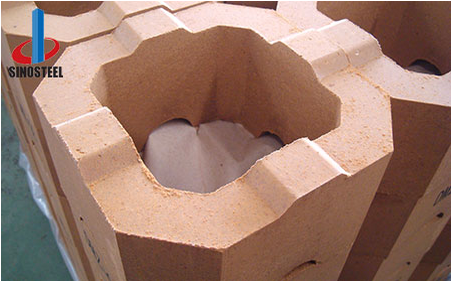The property and usage of Magnesia Brick
Refractoriness of magnesia brick high reaches above 2000 ℃, and refractoriness under load with the combination of phase's melting point and at high temperatures result in different liquid
phase without great changes. General magnesia brick's load softening temperature is at 1520 ~ 1600 ℃, and high purity magnesium boast a softening start temperature can reach 1800 ℃.
The difference between start refractoriness under load of magnesia brick and collapse of temperature is not big, it is because the main phase composition is periclase magnesia brick, but
periclase crystals within the magnesia brick is not crystalline network skeleton, but was cemented by combination. High purity magnesia brick's refractoriness under load start temperature can
reach 1800 ℃, mainly due to the combination between the periclase grain is forsterite or dicalcium silicate, it and MgO formed eutectic mixture's melting temperature is high, crystal lattice strength
is big and plastic deformation under high temperature is small, crystal particles combined are good.

The linear expansion rate of magnesia brick under 1000 ~ 1600 ℃ is generally 1.0% ~ 2.0%, and approximate or linear, in refractory products, thermal conductivity of magnesite brick is next only to
carbon brick, it reduces by the rise of temperature. Under the condition of 1100 ℃ water, magnesia brick's number of thermal shock is only 1 ~ 2 times. Magnesia brick to CaO and iron
oxide's alkaline slag resistance capability is strong, but to SiO2 and acidic slag's resistance is weak.
So in use can not direct contact with silica brick, and in general will be separated with a neutral brick. Under normal temperature, the conductivity of the magnesia brick is very low, but at high
temperature, the conductivity will not be ignored. Property of magnesia brick, because of the differences of adoptive raw materials, production equipment, technology measure have a large
difference.
phase without great changes. General magnesia brick's load softening temperature is at 1520 ~ 1600 ℃, and high purity magnesium boast a softening start temperature can reach 1800 ℃.
The difference between start refractoriness under load of magnesia brick and collapse of temperature is not big, it is because the main phase composition is periclase magnesia brick, but
periclase crystals within the magnesia brick is not crystalline network skeleton, but was cemented by combination. High purity magnesia brick's refractoriness under load start temperature can
reach 1800 ℃, mainly due to the combination between the periclase grain is forsterite or dicalcium silicate, it and MgO formed eutectic mixture's melting temperature is high, crystal lattice strength
is big and plastic deformation under high temperature is small, crystal particles combined are good.

The linear expansion rate of magnesia brick under 1000 ~ 1600 ℃ is generally 1.0% ~ 2.0%, and approximate or linear, in refractory products, thermal conductivity of magnesite brick is next only to
carbon brick, it reduces by the rise of temperature. Under the condition of 1100 ℃ water, magnesia brick's number of thermal shock is only 1 ~ 2 times. Magnesia brick to CaO and iron
oxide's alkaline slag resistance capability is strong, but to SiO2 and acidic slag's resistance is weak.
So in use can not direct contact with silica brick, and in general will be separated with a neutral brick. Under normal temperature, the conductivity of the magnesia brick is very low, but at high
temperature, the conductivity will not be ignored. Property of magnesia brick, because of the differences of adoptive raw materials, production equipment, technology measure have a large
difference.